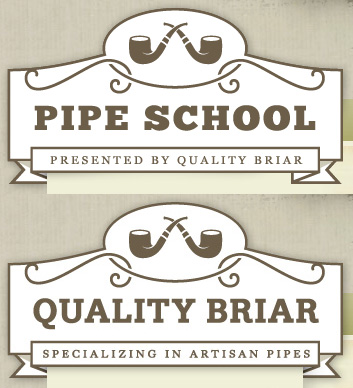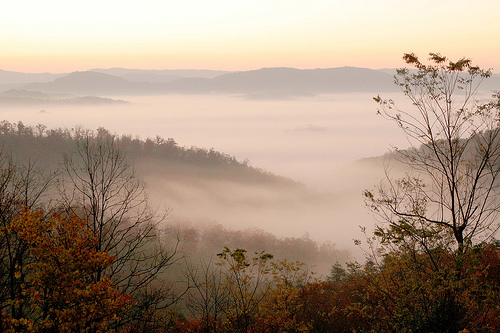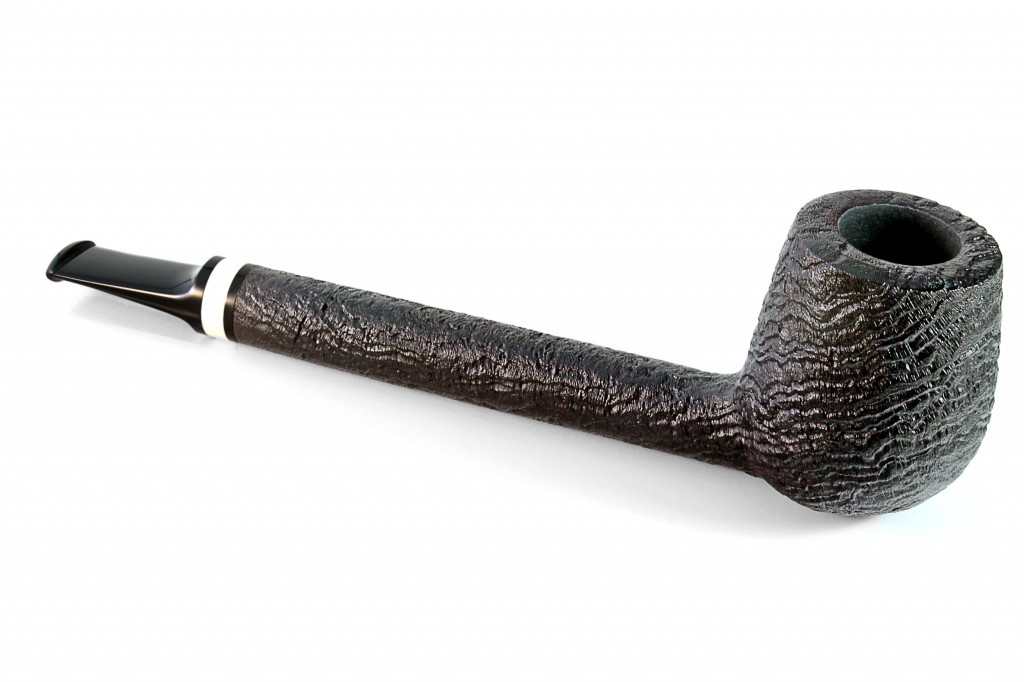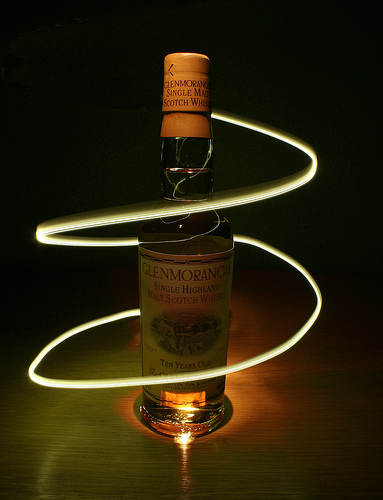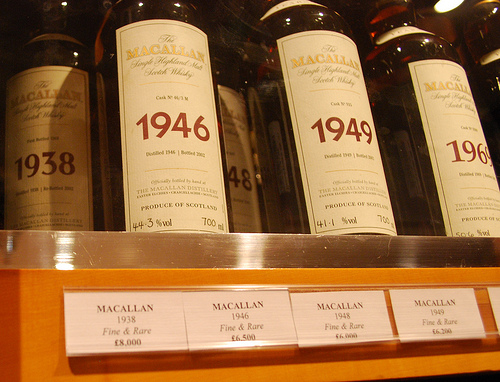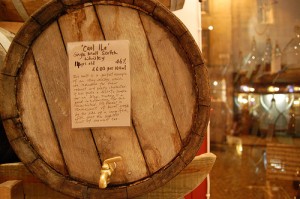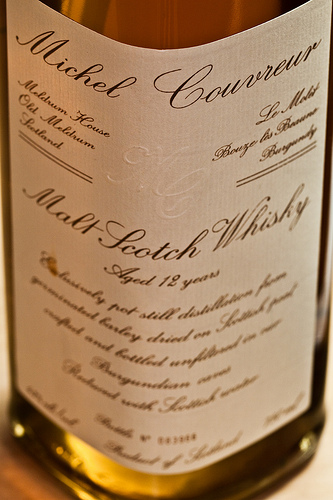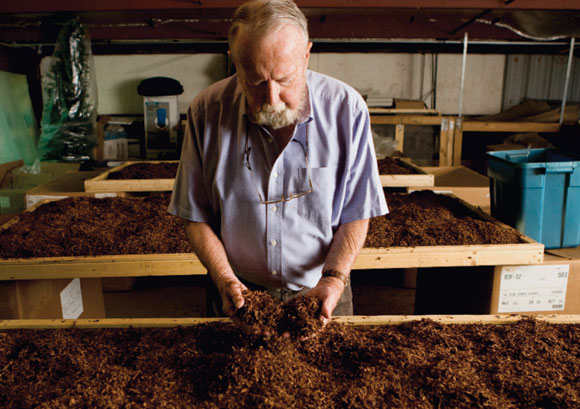Driving through the changing autumn leaves in Tennessee was like passing through a cool fireplace: vibrant shades of red and yellow and orange accompanied a refreshing fall breeze. The experience was coated by a film of anticipation.
I have very few free hours with my lady lately, with the weekends comprising the majority of that time. So what could convince me to leave Lauren in St. Louis and drive five hour to Nashville, Tennessee for the weekend? How about an opportunity to visit with Adam Remington, Steve Morrisette, Todd Johnson, and Jonas Rosengren (visiting from Sweden), all the while staying with the master-blaster, Bruce Weaver? Yeah, you know you would have done it, too.
I arrived to Bruce’s house late Friday night and was greeted by a smiling man and a yapping dog, Peanut, a little furball whom I would come to know very well over the weekend.
Bruce and I had only met in person once before, at the 2012 Chicago Pipe Show, but we had hit it off immediately and have spoken a lot on the phone. Not to mention, Bruce Weaver is perhaps the sweetest man on the face of the planet.
Mr. Weaver welcomed me in like a family member returning from out of town and immediately started apologizing. “I’m getting ready to move, so the place is a bit of a mess.” Clearly, this man has no idea what an apartment of a couple in their lower twenties looks like. The house was beautiful, full of equine paintings and phenomenal antiques.
Once I got everything inside, I quickly pulled out a thank-you present: Blanton’s bourbon. Bruce isn’t much of a drinker, but he poured himself a glass and we settled into his living room. Practically before I even sat down, Bruce was raving about his new house that he was going to be building. The floor plans looked beautiful and Bruce’s excitement was positively infections. Hell, by the end of the discussion, I was excited about the new house!
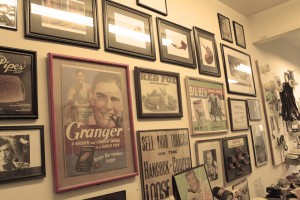 The next day, I awoke to a delicious cup of coffee and an English muffin and then quickly headed into Bruce’s workshop, located in his garage. Oddly, though I had never been in his workshop and have no experience around woodworking equipment, I felt instantly at home. The walls were covered with pipe-related prints from old movies, magazines, and a couple from Dustin Babitzke, and jazz was playing over the radio.
The next day, I awoke to a delicious cup of coffee and an English muffin and then quickly headed into Bruce’s workshop, located in his garage. Oddly, though I had never been in his workshop and have no experience around woodworking equipment, I felt instantly at home. The walls were covered with pipe-related prints from old movies, magazines, and a couple from Dustin Babitzke, and jazz was playing over the radio.
Dustin had actually been staying with Bruce just a little earlier in the week, learning the basics of shaping and drilling from Bruce. While Mr. Weaver makes shaping a pipe seem effortless, his true strength is often under-appreciated. “I’m a bit anal when it comes to internal mechanics,” Bruce told me. While this obsession does not really slow down Bruce’s production speed, it is a testimony to his constant quest for perfection and results in some of the cleanest, smoothest smokes one can find.
Sitting in his workshop, Bruce started rummaging through a cardboard box of briar blocks left by Dustin. “What am I going to do with these?” he asked no one in particular. Suddenly, Bruce looked at me as he held a long block in his rough, steady hands. “Do you like Lovats?”
Less than five minutes later, Bruce had sketched out the basic shape of the pipe on the block and was working on the lathe. “For billiards or Lovats or other shapes like that, I will use the lathe, but everything else is totally hand-shaped.”
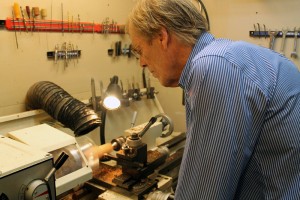 This was the first time I had ever seen a pipe being made in person. It was hypnotizing. Watching the pipe materialize from what was practically no more than a child’s building block took me back to my AP Art History class in high school. In the cool classroom with no light but the dim projector, my teacher told us how Michelangelo would say that he saw the sculpture inside the marble block and that his job was simply to let it out…from marble to briar, the principle remains the same.
This was the first time I had ever seen a pipe being made in person. It was hypnotizing. Watching the pipe materialize from what was practically no more than a child’s building block took me back to my AP Art History class in high school. In the cool classroom with no light but the dim projector, my teacher told us how Michelangelo would say that he saw the sculpture inside the marble block and that his job was simply to let it out…from marble to briar, the principle remains the same.
Bruce would kill me for telling this (forgive me), but there was bit of a hiccup with the pipe. Due to circumstances beyond his control, the tobacco chamber got drilled a quarter of an inch too deep. When Bruce saw this, he stood with his jaw suspended mere inches off of the floor. “I can’t believe I did that,” he breathed.
For the next fifteen minutes, Bruce barely noticed that I was around and simply kept repeating, “I can’t believe I did that.” One might guess that his frustration was a result of the cost of the briar that was just used, but this was a block that Dustin left him for free. The real reason, and the whole purpose of my telling you about this experience, is that Bruce Weaver is an incredibly skilled pipe maker who takes remarkable pride in his work. Anything less than perfection, especially when it comes to mechanics, is simply unacceptable.
A minute after Bruce returned to Earth and was once again smiling and laughing, my phone rang and a picture of one of my most beautiful pipes showed up on my caller-ID: Adam Remington. (That’s right. I put one of his pipes and his caller-ID. What’s the big deal?)
I opened Bruce’s front door to the smiling faces of Adam, his wife, Michelle, and Jonas Rosengren. Hugs and typical greeting flowed freely as Bruce shared his recent tragedy. Even the other pipe makers couldn’t help but grin at his frustration. “This is what I get for having ten thumbs,” Bruce joked.
Within half an hour, Adam, Michelle, Jonas, and I were piled into Adam’s car and on our way to a Nashville tradition: Prince’s Hot Chicken Shack. It didn’t take much cajoling to get me to go; the words “hot” and “chicken” on their own would have convinced me, but with the two put together, I was ready to run there! According to its online reviews, the chicken there is hot enough to “make a grown man cry”.
The neighborhood that we traveled to was pretty different from where we had started: the buildings weren’t in the best shape and liquor stores, gun stores, and churches shared walls (always a good sign).
It was 1:45 when we pulled up to Prince’s, which fits the description of a “hole-in-the-wall” perfectly. Even at that time in the afternoon, the restaurant wasn’t going to be open for another fifteen minutes. “No big deal,” Adam said. “We should probably go pick up some drinks anyway.” Prince’s, you see, doesn’t offer anything to drink aside from a few selections from a vending machine.
While Michelle waited in the car, Jonas and I ran into a local gas station to find something to drink.
“I don’t know American beer,” Jonas said. Frankly, the American beer selection offered in this fine establishment was nothing you would want to know. Instead, we opted for Ireland: Guinness Extra Stout. Thus, armed with a six-pack of Guinness and willing stomachs, we headed back to Prince’s.
By the time we got back, Steve Morrisette was already holding a table for us, dressed in a white suit and fedora, and the line for chicken was almost out of the door. I knew then that this really was a tradition in Nashville. Once we got to the front of the line, I opted for extra hot out of the spice options. People stopped and stared when I ordered. I could practically see the anticipation in their eyes, hoping that I wouldn’t be able to handle it.
Once we got our order, I quickly took an enthusiastic bite. Wow, it was delicious! I had done a ghost pepper hot wing challenge back in St. Louis and the spice at Prince’s was nothing in comparison, but it was far more delicious. One person who saw me order came by and asked, “How you doing with that?” He seemed slightly let down when I replied with a happy smile…sadist.
We split the pack of Guinness and shared laughs and stories. Adam, Jonas, and Michelle were on one side, while Steve and I were on the other. It was a blast to sit down to eat with these people that I had only gotten to meet briefly before and realize that, along with being incredibly talented, they were all incredibly nice.
 We quickly left after finishing and ran over to The Briar Studio, a pipe workshop set up by Todd Johnson and Bruce Weaver that would make any artisan feel like a kid in a candy store. Essentially, it is a fully functioning pipe workshop multiplied four times: four lathes were set up side-by-side, four shaping wheels, and four workbenches in the back room.
We quickly left after finishing and ran over to The Briar Studio, a pipe workshop set up by Todd Johnson and Bruce Weaver that would make any artisan feel like a kid in a candy store. Essentially, it is a fully functioning pipe workshop multiplied four times: four lathes were set up side-by-side, four shaping wheels, and four workbenches in the back room.
We settled in for a while as Jonas sipped on a cup of coffee. While we waited for Todd Johnson to get to the shop, Adam showed me a beautifully sandblasted pipe that was part bulldog and part horn and a lot of plateau. “If I end up going to Vegas,” Adam said, “this one will be coming with me.”
“I don’t think it will be,” I grinned. “I think it’s probably heading to St. Louis!”
Once Todd arrived, we all chatted for a while about different pipe makers, the studio, the state of the pipe-economy in America and oversees, and other random things.
As the sun started to set, we all packed up to run over to Uptown’s Pipe Shop, but had a bit of a delay. Less than a mile from The Briar Studio, Todd’s car ran out of gas in the middle of the road, which resulted in a great deal of laughs and some memorable pictures that I simply must get from Jonas.
(Review on Uptown’s to be coming later…that’s not why we’re here right now!)
After a brief stop in Uptown’s, just long enough to grab some nicely aged tobacco and look around, Adam, Jonas, Michelle, and I were on our way back to Bruce’s, to be joined later by Steve.
The rest of the evening was a blur of bliss: port, bourbon, laughter, pipes, and friends. One of the most pleasant moments involved my breaking in my Bruce Weaver blowfish in some tobacco given to me by Mr. Weaver himself. “How’s that smoking?” Bruce would ask me, constantly concerned about his piece. The other experience that made me ridiculously happy was when Adam realized that he had come to Bruce’s without his pipe. Luckily, I had a back full on pipes with me. In fact, I had a pipe that I had recently gotten off of Smokers’ Forums made by none other than Adam Remington and I had yet to smoke. So the first bowl out of this pipe while I had owned it was by the man who had carved it. Judging by the look on Adam’s face, he appreciated the Romance of it, as well.
 It was after midnight by the time that everyone departed and another half-an-hour before Bruce and I folded and headed to bed.
It was after midnight by the time that everyone departed and another half-an-hour before Bruce and I folded and headed to bed.
The next morning started early and rapid fire. Bruce, not being one to settle for anything but the best, had decided to make another Lovat.
“I may have ten thumbs, but I’m a stubborn blastard.” That’s a word Bruce used often to refer to himself: blastard. It seemed to makes sense, given that Bruce is known for his sandblasting on his pipes and Bruce, constantly self-deprecating, uses the word blastard to both own his specialty and manage to not sound too proud.
Like before, within five minutes, the pipe was drawn up and we were back standing in front of the lathe. “We’re not going to mess up this time, all right?” Bruce looked at me with joking accusation in his eyes. “If it happens again, you might just be bad mojo!”
This time, the mojo was good. After about half an hour at the lathe, the bowl and stem were roughly shaped, the air-hole drilled, and the tobacco chamber perfectly finished.
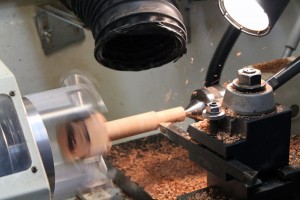 “Yes!” Bruce cheered. “Now the fun part.”
“Yes!” Bruce cheered. “Now the fun part.”
Bruce and I swapped chairs and he settled in front of the wheel that he uses for the hand shaping. With his elbows tucked into his side, Bruce rocked back and forth at the wheel like a man in a meditative trance. “It’s all in the body,” Bruce said, as if reading my thoughts. “I can move in a straight line with my body, but you can do it like that with your arms.”
Once or twice as he was shaping the pipe, Bruce stopped and put the chin of the bowl in the gap between his thumb and forefinger or the tip of his thumb where stem and bowl meet.
“You know what a French curve is?” Bruce asked as he held his pipe to his thumb, balancing it there. “This area on your hand is the perfect French curve.” All skepticism aside, I watched Bruce constantly checking the chin on his hand. The closer and closer the pipe got to fitting completely evenly, the closer and closer the pipe came to looking complete and fully formed.
The next step was watching Bruce hand-cut the ebonite for the pipe’s stem, along with a beautiful ivory ring. “Get ready for the stinky stuff,” Bruce warned as he cut into the ivory.
With an hour before I had to hit the road back to St. Louis, the stem was roughly formed and the rings glued and ready to proceed. Bruce hand drilled the V of the air chamber into the stem and then did something really indicative of his obsession with internal mechanics perfection: he polished the inside of the stem so that it was “smooth as glass”. With a device of his own creation, he had the inside smooth as could be within thirty seconds. Looking through the stem, I couldn’t see even the smallest imperfection. “Most people will never even notice this part,” Bruce said, “but they will enjoy the benefits.” He smiled proudly.
After polishing the inside of the stem, he put it aside. “I’d rather you get to see a little of the sandblasting process that watch the finer points of stem shaping.”
Frankly, I’d been waiting for this the whole time I’d been I’d been in Nashville. Bruce Weaver is known for many things, but he is, more than anything, known as a master-blastard – I mean blaster! Damn, now he’s got me doing it.
A sandblasting setup is a well-sealed cube with a clear top, rubber gloves that reach inside of it, and an air-compressor gun inside. Filling the unit is a white powder composed of extremely small glass beads. This is the material that is forced out of the air compressor and eats away at the softer parts of the briar, leaving the beautiful sandblast design. In reality, the term should be glass-blast for Bruce, but that’s just a nuance.
As I watched through the haze of flying glass particles, the growth rings hidden in the briar began to pop-out, revealing a slanted design that would have been invisible otherwise.
“Oh, this is going to be cool!” Bruce exclaimed several times.
One of the things that makes Bruce such an exceptional artisan is his dedication to constantly having fun. “You’ve got to have fun with what you do.” One of Bruce’s most well-known projects of fun is known as the Pipedelic, a sandblasted volcano with the rings colored in a kaleidoscopic hues. It is one of the best representations of Bruce Weaver as a man and as a carver: fun, skilled, unusual, and one-of-a-kind.
The previous evening, before everyone left, Bruce asked for help coming up with a new shape to try. “I just finished the corndog and the cornfish, so I need something new.” A minute later, Michelle suggestion the combination between a horn and a bulldog, resulting in a “horndog”.
Bruce burst into laughter. “The horndog! That’s perfect for me, isn’t it?” When Jonas joined in the laughter, Bruce turned to him and said, “I’m just a dirty, old blastard.”
Bruce Weaver calls himself many things: Ten-thumbed. Blastard. But my time in Nashville realized that he is so much more than he will ever give himself credit. If you have not had the pleasure of owning one of Bruce’s pipes, I cannot recommend it enough. However, be sure to contact him when you order it. You will never regret a pipe or a conversation from Bruce Weaver.
